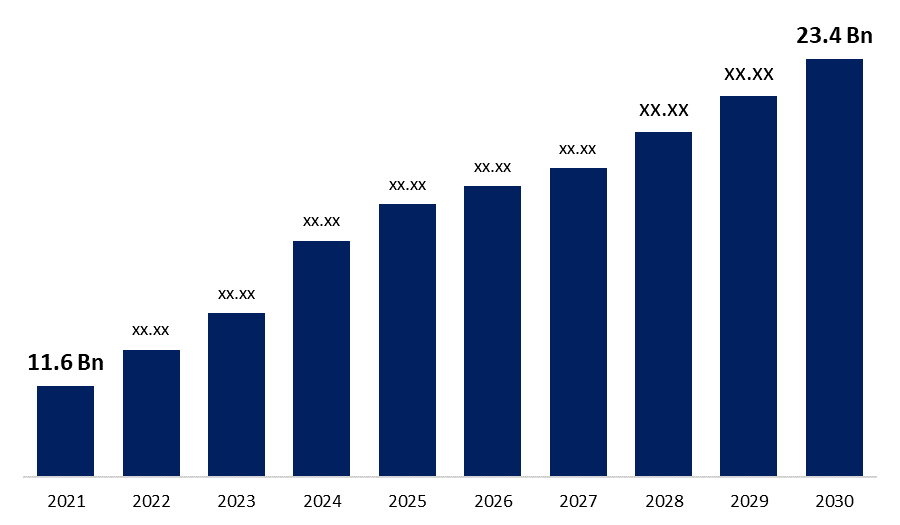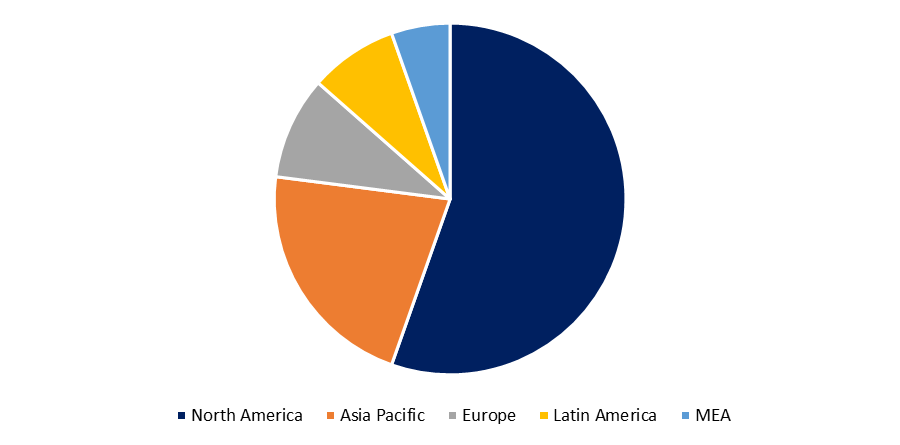Global Nano Biosensors Market Size, Share & Trends, COVID-19 Impact Analysis Report, By Type (Nanoparticle-Based Sensors, Nanotube-Based Sensors, And Nanowire Based Sensors), By Product (Wearable Biosensors, And Non-Wearable Biosensors), By Industry Vertical (Healthcare, Consumer Electronics, Food & Beverage, Aerospace & Defense, And Others), And By Region (North America, Europe, Asia-Pacific, Latin America, Middle East, And Africa), Analysis And Forecast 2021 - 2030
Industry: HealthcareNANO BIOSENSORS MARKET: OVERVIEW
The Global Nano Biosensors Market Size was valued at USD 11.6 Billion in 2021, the market is projected to grow 24.4 Billion in 2030, at a CAGR of 7.90%. Nano biosensors are innovative nanobiotechnology-based sensors that are non-invasive, sensitive, and well-designed. Nano biosensors create real-time response signals that are easily collected and analyzed. Different nanomaterials, including nanotubes, nanowires, nanoparticles, nanocrystals, and nanocomposites, are used in the nano biosensors. Applications for nano biosensors can include determining if an ecosystem has enough natural resources, such as good soil and accessible ground water. These lightweight, portable equipment for the agriculture sector can help farmers monitor and manage the soil conditions locally. Prior to the beginning of illnesses, soil fertility, pH, moisture content, mineral concentrations, and pest detection have all been examined using nano biosensors.

Get more details on this report -
COVID-19 ANALYSIS
The COVID-19 outbreak will have a huge impact on global industrial expenditure over the next several years because a large number of businesses that governments throughout the globe have deemed non-essential are currently inactive and suffering enormous losses. Through the end of 2021, this will have an impact on their tech spending. COVID-19 is also pushing various manufacturers to depend more heavily on digitalization and automation for long-term operations in order to decrease the cost effect of the pandemic and other potential economic crises. It is believed that the COVID-19 outbreak would have a brief effect before going away. However, in light of the current pandemic, COVID-19 offers businesses the chance to make much-needed operational improvements with an emphasis on developing networking technologies.
Global Nano Biosensors Market Report Coverage
| Report Coverage | Details |
|---|---|
| Base Year: | 2021 |
| Market Size in 2021: | USD 11.6 Billion |
| Forecast Period: | 2021 - 2030 |
| Forecast Period CAGR 2021 - 2030 : | 7.90% |
| 2030 Value Projection: | USD 23.4 Billion |
| Historical Data for: | 2017 - 2020 |
| No. of Pages: | 197 |
| Tables, Charts & Figures: | 94 |
| Segments covered: | By Type, By Product, By Industry Vertical, By Region |
| Companies covered:: | Abbott, Roche, Medtronic, Bio-Rad Laboratories, Inc, DuPont, Biosensors International Group, Ltd, Cytiva (UK), Dexcom, Inc, Lifescan IP Holdings, LLC, Masimo, Nova Biomedical, Universal Biosensors, Others |
| Growth Drivers: | Increasing Prevalence in Monitoring of The Environment Drive Market Growth |
| Pitfalls & Challenges: | COVID-19 Empact, Challenge, Future, Growth, & Analysis |
Get more details on this report -
NANO BIOSENSORS MARKET: TREND
Development And Applications of Nano Biosensors for Sustainable Agricultural and Food Industries
The world's population is predicted to exceed 8.5 billion, and it will continue to grow exponentially until it reaches the 9.8 billion marks by 2050, posing challenges for the production of food and natural resources. Reduced land area, a lack of food and crops, competition for natural resources, and a focus on increasing crop productivity under unfavorable environmental circumstances are other significant issues. Additionally, another issue that is causing concern worldwide is the contamination of food with microbes during storage and processing. In order to increase the efficiency of natural resources, plant hormones, a variety of diseases, herbicides, fertilizers, and metal ions used in the production of agricultural and food products, it is urgently necessary to develop fresh sustainable ways and/or procedures. Recently, improved functional materials made possible by nanotechnology have been applied to improve current agri-food industry procedures.
NANO BIOSENSORS MARKET: DRIVERS
Increasing Prevalence in Monitoring of The Environment Drive Market Growth
The close relationship between environmental pollution and human health, environmental monitoring is a global priority. Many analytical techniques and methods have been developed to detect and monitor pollutant levels (pesticides, toxins, bacteria, drug residues, etc.) in natural water bodies. The most recent trend in modern analysis is to measure pollutants in the field in real time. Biosensors have been used as cost-effective and quick analytical techniques for this purpose. Impedance biosensors have the greatest potential for use as simple and portable devices among biosensors. These sensors involve applying a low-amplitude alternating current voltage to the sensor electrode and measuring the in-/out-of-phase current response as a function of frequency, which is integrated with some biorecognition element on the sensing electrodes that can bind to the target, modifying the sensor electrical parameters.
NANO BIOSENSORS MARKET: RESTRAIN
Detection Limit, Detection Time, And Specificity Limit Market Growth
When designing biosensor systems, detection time poses significant challenges, such as finding a suitable technology while maintaining the highest sensitivity and specificity. Specificity is regarded as the most important property of a biosensor because it describes the sensor's ability to distinguish between target and non-targeted biological entities in a sample. When testing product quality on a food processing production line, the detection time of a sensor becomes important. The quality control test must be completed quickly in order to reduce storage costs and the time it takes for the product to enter the market.
NANO BIOSENSORS MARKET: SEGMENTATION
The global Nano Biosensors Market is segmented by Type (Nanoparticle-Based Sensors, Nanotube-Based Sensors, and Nanowire Based Sensors), By Product (Wearable Biosensors, and Non-wearable Biosensors), By Industry Vertical (Healthcare, Consumer Electronics, Food & Beverage, Aerospace & Defense, and Others), and Region (North America, Europe, Asia-Pacific, Latin America, and the Middle East and Africa).
By Product Insights
Based on the product the market is segmented into the wearable Biosensors, and Non-wearable Biosensors. Wearable biosensors accounts to holds the highest share in the global nano biosensors market. Wearable biosensors have sparked considerable interest due to their potential to transform traditional medical diagnostics and continuous health monitoring concepts. Wearable biosensor applications aim to shift from centralized hospital-based care systems to home-based personal medicine, lowering healthcare costs and diagnosis time. We can now see that wearable biosensors are causing a wave of innovation in society. Their convenience and improved use can provide a new level of exposure to a patient's current health status. This real-time data availability enables better clinical decisions, which leads to improved health outcomes and more efficient use of health-care systems.

Get more details on this report -
SEGMENTATION: BY REGION
Based on the Region, the Global Nano Biosensors Market is categorized into North America, Europe, Asia-Pacific, Latin America, the Middle East and Africa.
North America region is dominating share of the global Nano Biosensors market due to the expanding usage of smart connected devices, the industrial Internet of things, and flexible networks. The constant rise in demand for IoT sensors and linked devices will facilitate the adoption of Nano Biosensors. The increased adoption of cloud and mobile technologies is what is driving the market for Nano Biosensors. The increased use of the industrial Internet of things and smart connected devices will increase demand for Nano Biosensors in South America. However, due to the tremendous expansion of the network infrastructure, Europe is the second-largest market for Nano Biosensors. Market expansion in the area will benefit from the implementation of industrial IoT solutions.
Asia Pacific region is dominating share of the global Nano Biosensors market due to presence of a large population base and rising incidences of various lifestyle diseases are the primary factors driving market growth in APAC. In terms of foreign investment, China's healthcare industry has gradually opened up to foreign participation, both through the removal of items from the National Negative List and the addition of items to the National Encouraged List. New raw materials for vaccine production and medical institutions were added to the 2019 National Encouraged List in 2019. This suggests that China is now encouraging healthcare investments and opening up opportunities for foreign investors to benefit from preferential policies and tax rates. Such policies are expected to attract a number of opportunities for the biosensors market in the future.
NANO BIOSENSORS MARKET: KEY PLAYERS
- Abbott
- Roche
- Medtronic
- Bio-Rad Laboratories, Inc.
- DuPont
- Biosensors International Group, Ltd.
- Cytiva (UK), Dexcom, Inc.
- Lifescan IP Holdings, LLC
- Masimo
- Nova Biomedical
- Universal Biosensors.
- Others
NANO BIOSENSORS MARKET: RECENT DEVELOPMENT
- January 2021- Roche and Sysmex have signed a Global Business Partnership Agreement (GBP) to provide hematology testing solutions. The new agreement aims to improve clinical decision-making and customer experience by utilizing IT systems. This successful, long-standing collaboration continues to evolve and bring hematology testing innovations to laboratories around the world.
- December 2020- Abbott announced the approval of its next-generation sensor-based glucose monitoring technology, FreeStyle Libre 2, by Health Canada for adults and children (4 years and older) with diabetes.
NANO BIOSENSORS MARKET: REPORT OVERVIEW
The scope of the report includes a detailed study of regional markets for Global Nano Biosensors Market. The Global Nano Biosensors Market is segmented by Network Type, Component, Deployment Type, End User, and Region. It reveals the market situation and future forecast. The study also covers the significant data presented with the help of graphs and tables. The report covers information regarding the competitive outlook including the market share and company profiles of the key participants operating in the Global Nano Biosensors Market.
SEGMENTATION
By Type
- Nanoparticle-Based Sensors
- Nanotube-Based Sensors
- Nanowire Based Sensors
By Product
- Wearable Biosensors
- Non-wearable Biosensors
By Industry Vertical
- Healthcare
- Consumer Electronics
- Food & Beverage
- Aerospace & Defense
- Others
By Region
- North America- U.S., Mexico, Canada
- Europe- UK, France, Germany, Italy, Spain, Rest of Europe
- Asia-Pacific- China, Japan, India, South Korea, Rest of Asia Pacific
- South America- Brazil, Argentina, Colombia, Rest of South America
- The Middle East and Africa- GCC, South Africa, Rest of Middle East & Africa
Need help to buy this report?